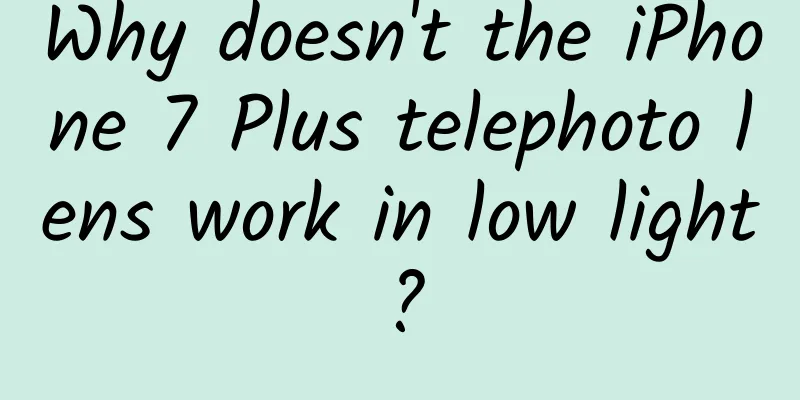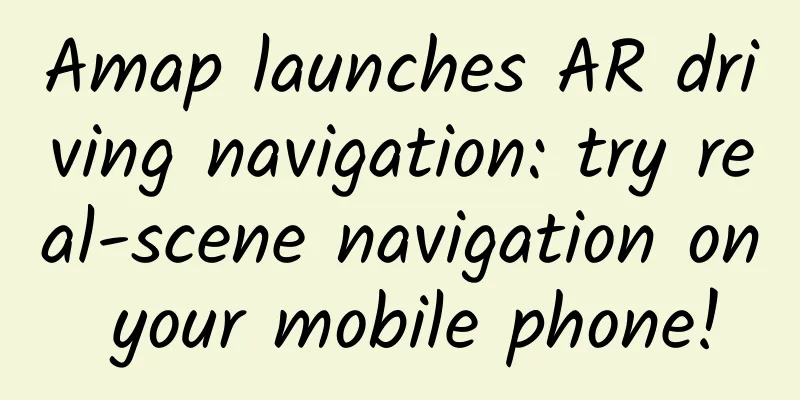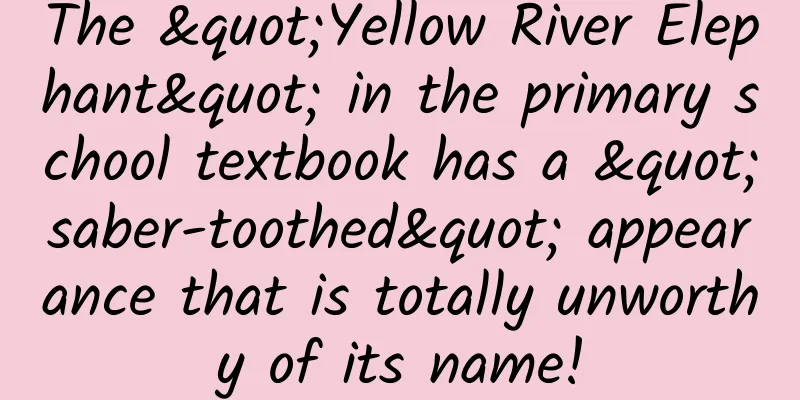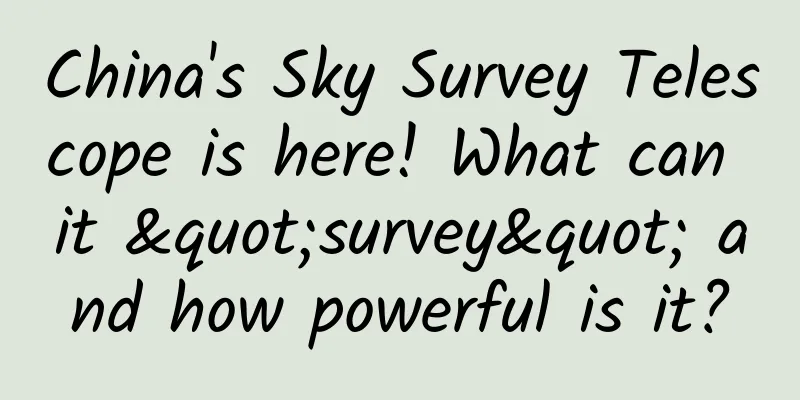Why doesn't the iPhone 7 Plus telephoto lens work in low light?

|
This year's dual-camera upgrade to the iPhone 7 Plus is the biggest leap forward in camera since the iPhone was first introduced. The iPhone 7's 28mm wide-angle lens now has an f/1.8 aperture, which allows 50% more light to enter the sensor, while the 56mm telephoto lens has countless applications for improving image quality. These two lenses can work together or separately to give users the best photos. Want to take a landscape photo? Want to take a close-up photo of a person in the sun? Want to take a close-up photo of a person in the shade? All of this is achieved by using this camera system in different combinations. Let's be honest: Apple's original intention was to design it as a system that works with the camera app to make up for the problems of smartphone camera photography to the greatest extent possible. Smartphone cameras are only 1/5 the size of DSLR or professional video cameras, so the photos they take are bound to have shortcomings and poor light analysis. For example, the above pictures were all taken in the "2x" setting mode of the camera app, and only one of them was taken with the telephoto lens. Can you tell which one it is? That’s because the telephoto lens in the iPhone 7 Plus isn’t really a separate lens. It does allow users to take really nice photos with lots of detail in bright light. If you don’t often use the Camera app to take photos in brightly lit scenes, then you probably don’t use the telephoto lens very often. Why? Every time you take a photo with your iPhone, the image signal processor (ISP) performs billions of operations to produce the best possible image. This includes automatically setting the shutter speed, ISO, exposure, and color temperature for the dual-camera system. Here’s a photo taken directly from the Camera app with the iPhone 7 Plus telephoto lens in 2x mode. The iPhone 7 Plus’s multiple-camera system actually presents the ISP with another problem: which lens should it use? Previously, when the iPhone had only one lens, the ISP didn’t have to make this choice, but now the Camera app has a choice, and can choose to use the secondary lens and sensor to take a better photo. The ISP will decide on its own whether to use both lenses, just the wide-angle lens, or just the telephoto lens, based on lighting, focus ratio, and other conditions. The choice of processor is generally fine, so you don't need to worry about it. But if you want to shoot with the telephoto lens, just hitting the 2x button in the camera app won't do: the image signal processor is the one that decides whether to use both lenses or the wide-angle lens, not the user. The technology behind it The wide-angle lens and sensor on the iPhone 7 Plus are in many ways the same as those on previous iPhones, with a 3.99mm frame, 10x digital magnification, and a 1/3.06-inch sensor. What's new in the wide-angle lens is the aperture has been changed from f/2.2 to f/1.8. The aperture size directly affects the amount of light that can enter, and the smaller the number, the more light that can enter, which gives you better images when shooting in a dim room or at night. The wide-angle lens also supports optical image stabilization, which makes low-light photo and video recording a better experience. It also has a shorter minimum focusing distance than the telephoto lens (so you can get closer to the object without losing focus, which is great for macro photography). This year, the iPhone 7 gets its own telephoto lens and sensor: a 6.6mm lens that’s great for portraits and close-ups. But its specs aren’t as high as the main wide-angle lens. The telephoto has an aperture of f/2.8, no optical image stabilization, and a smaller 1/3.6-inch sensor. But it’s impressive that Apple was able to fit a telephoto lens into such a thin body, and it’s also a challenge to squeeze in extra OIS or a better aperture. Whenever possible, Apple has two lenses and sensors working at the same time, taking photos at the same time, to compensate for each other’s shortcomings and take better photos. Is the wide-angle lens better at focusing? Yes. Is the telephoto lens better at exposing and balancing light? Yes. That’s the simplest and most concise summary of the work of the iPhone’s image signal processor, which performs billions of calculations every millisecond. Limitations of the iPhone Telephoto Lens Unfortunately, when shooting 2x photos, the limitations of the telephoto lens hardware prevent users from taking good photos in low-light conditions - this is where the iPhone's software comes into play. Before discovering this problem, a user was very confused why the telephoto image when taking photos with an iPhone 7 Plus in a restaurant looked the same as the photos taken with previous iPhones, but after looking at the metadata, it became clear: the photos he took were actually taken with the wide-angle lens digitally zoomed at 2x. At first, the user thought it was an operation error, but after repeated testing, he confirmed his doubts: when the camera application is in low light conditions, the telephoto lens will hand over control to the wide-angle lens. You can test it yourself, too, by placing your finger on the wide-angle lens and entering 2x mode: If the light in your location is relatively bright, the photo you take will be the same as usual. If the light in your location is relatively bright, you may see a black patch in the image, and that patch is actually your finger. As mentioned above, which lens to use depends on the image signal processor. When you take a photo, it "looks" at the possible images from both lenses before deciding whether to use the wide-angle lens alone, the telephoto lens alone, or a combination of the two lenses. In low-light conditions, the ISP decides that the telephoto lens with an aperture of f/2.8 can't produce as good a picture as the wide-angle lens because it doesn't have stabilization technology and has a smaller sensor, so it chooses the wide-angle lens. The ISP's decision is probably correct: the user test uses ProCamera to shoot, 1/13 shutter speed, wide-angle 2x and telephoto, and the results are shown in the figure (the wide-angle lens is on the left). In comparison, its focus is sharper, which is partly because the telephoto lens requires a longer minimum focusing distance than the wide-angle lens. Even if the user has tried to adjust the distance when shooting, the final result is not ideal. Conclusion This article is not about whether the telephoto lens is useful. In good light conditions, we can indeed take very good photos with the telephoto lens, and even if you don't take photos directly in 2x mode, the telephoto lens will assist the wide-angle lens to take better pictures. After testing, users believe that this is not very meaningful for the average user who uses the camera app or other social media apps to take pictures. The iPhone's ISP will choose what it thinks is the best tool to take the best photo for you. Like Instagram's previous square format, the 2x mode allows users to combine their photos in a different way. If you like to take pictures with the telephoto lens, you can try using a third-party app that supports both lenses at the same time - Apple provides the API for this reason. Features like RAW and manual camera adjustments are prepared for those who are new to photography. For those who want to take good photos, their focus may be on other aspects. But Apple's ISP is right: you can't take good pictures with the telephoto lens in low light. Without the ISP, and with such a small aperture, it doesn't have this function. For now, if you want to try to shoot with the telephoto lens using a third-party app, you're better off shooting in brighter light or using tools such as stabilizers. As a winner of Toutiao's Qingyun Plan and Baijiahao's Bai+ Plan, the 2019 Baidu Digital Author of the Year, the Baijiahao's Most Popular Author in the Technology Field, the 2019 Sogou Technology and Culture Author, and the 2021 Baijiahao Quarterly Influential Creator, he has won many awards, including the 2013 Sohu Best Industry Media Person, the 2015 China New Media Entrepreneurship Competition Beijing Third Place, the 2015 Guangmang Experience Award, the 2015 China New Media Entrepreneurship Competition Finals Third Place, and the 2018 Baidu Dynamic Annual Powerful Celebrity. |
>>: Samsung Note 7 fire incident: Insider reveals: Apple's rush to meet deadlines caused the problem
Recommend
Mastering these 10 tools will help you quickly become an operations and promotion expert!
In the Internet era, there are many tool -type st...
Are your teeth sensitive after teeth cleaning? A periodontist will tell you →
As a periodontal specialist, I often encounter pa...
APP promotion operation: Internet promotion traffic circulation system
Operations are divided into two parts: the first ...
2020 Double 11 surprise red envelopes, what time will the Double 11 surprise task red envelopes be sent every day?
This year's Double Eleven can be said to have...
The operational procedures of event planning scheme are universal!
This template is a relatively general activity te...
A quick training course on making elegant PPT
Introduction to the resources of the quick traini...
Mining offline traffic dividends: Is it the “scenarios” that have obsessed offline businesses?
It is an indisputable fact that online traffic is...
Is there formaldehyde in the wall renovation paint in Lanzhou? How long does it take for the formaldehyde in the paint to be released after painting the wall?
There are many materials used for wall renovation...
7 Myths About Men's Health: Do You Believe Them?
Author: Xue Qingxin, registered dietitian Reviewe...
Google self-driving cars crashed three times last month, but careless drivers are more dangerous
Several foreign media reported three traffic acci...
Getting started with React and Webpack
I've been learning React.js recently. Before,...
A master who consumes 15 million in a single month teaches you: the rhythm of massive Qianchuan release and improving ROI
A master who consumes 15 million in a single mont...
CES Observation: Female users become the new favorite of smart hardware industry
Recently, CES 2016 closed successfully under the ...
In the New Year's greetings, those great weapons of the great powers that can "go to the sky, the sea and the land"
President Xi Jinping has delivered New Year's...









